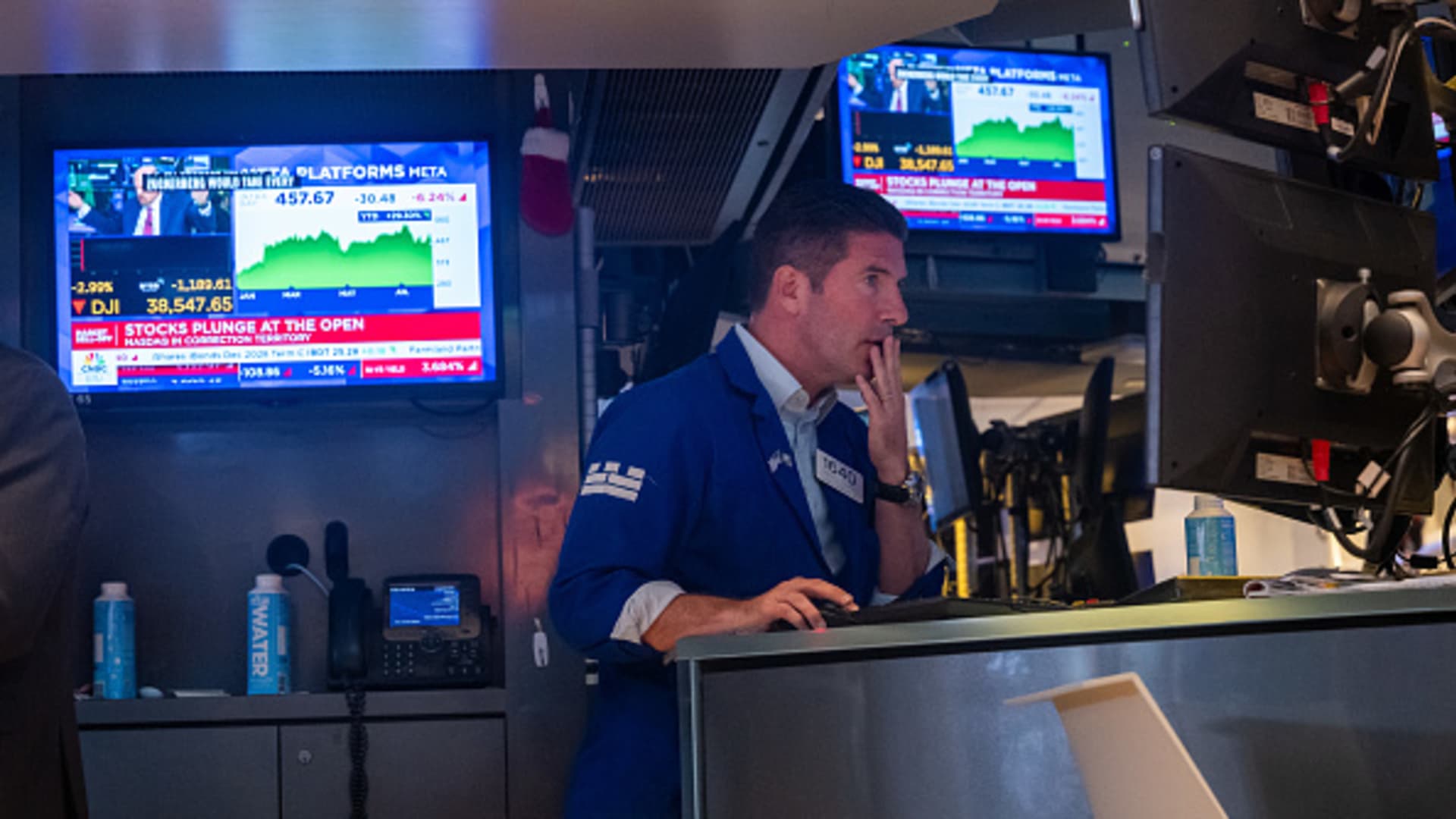Traders work on the floor of the New York Stock Exchange (NYSE) on August 05, 2024, in New York City.
Spencer Platt | Getty Images
Any number of suspects could be blamed for Monday’s market beatdown, ranging from worries about the economy and seemingly slow-footed response from the Federal Reserve to the unwind of a popular global currency trade and concerns over corporate earnings.
Those all played a part in some shape or form, and each helped tell a story of a shifting investing landscape that likely has not fully played out fully.
“This is very much a regime shift that is affecting sentiment in a big way,” said Robert Teeter, chief investment strategist at Silvercrest Asset Management. “The market got a little bit ahead of itself in that run-up that it’s had. Now we’re correcting back to where we were in April and May, and it’s been a violent correction because it’s been a very big wake-up call.”
That call came in the form of a sell-off that saw the Dow Jones Industrial Average lose more than 1,200 points in early trading Monday and briefly put the S&P 500 down 9% from its July record.
Market averages slide
Treasury yields tumbled as bond traders bet on both a slowing economy and a Fed that would be forced into lowering rates soon.
Concerns over the state of the economy began Thursday, when disappointing data on manufacturing and layoffs fueled concern over the economy. Those were exacerbated Friday, when the Labor Department reported lower-than-expected job creation numbers and a rising unemployment rate in July that triggered a reliable recession signal known as the “Sahm Rule.” Soon, traders began pricing in aggressive Fed rate cuts after expecting the central bank to do little the rest of the year.
Indeed, policymakers were not far from investors’ minds, as sentiment grew that the Fed is waiting too long to ease short-term benchmark borrowing rates, which currently sit at 23-year highs.
Market pricing Monday implied a near certainty that the Fed would cut by half a percentage point at its September meeting and follow that with reductions in November and December that cumulatively would total 1.25 percentage points.
‘A perfect storm’ sinks markets
“It’s just a perfect storm of slowing growth, crowded positioning and risk-off sentiment that’s all coming to a head at the same time,” said John Belton, portfolio manager at Gabelli Funds. “The market’s really going to follow the data now, and you’re going to have easing monetary policy as a backdrop.”
Along with economic and monetary policy concerns, the market had to contend with the unwinding of a popular trade that entailed borrowing in cheap currencies such as the Japanese yen and buying higher-yielding currencies — the “carry trade” that has helped propel global markets with liquidity.
An unexpected rate hike last week from the Bank of Japan as well as currency intervention there have sparked fears that the carry trade is over. The yen rallied sharply Monday, and Japanese stocks had their worst day since Black Monday in October 1987.
Corporate earnings also have come under question.

Second-quarter earnings season has seen 78% of companies beat profit forecasts, but just 59% top revenue estimates, according to FactSet. Moreover, it’s been the forecasts from some Silicon Valley highfliers that have raised the market’s hackles, and companies such as Nvidia — down 11% over the past five days — have paid the price.
Finally, geopolitical concerns persist, with markets worried over the situation in the Mideast and Ukraine, as well as a rapidly changing political landscape in the U.S. that has seen likely Democratic nominee Kamala Harris vault into a virtual tie with Republican Donald Trump in many polls.
Put that against the backdrop of a market with high valuation — the S&P 500 last week was trading at 20.7 times forward earnings, or about 15% above its normal five-year level — and it had all the makings of a sell-off waiting to happen.
“This is the confluence of a very high market that has been soaring and riding on a lot of sentiment and emotion. For several months now, the momentum trade has been the successful trade,” said Michael Farr, CEO of Farr, Miller & Washington.
“While folks make fundamental arguments that give them comfort, everybody in the back of their minds knows stuff doesn’t go up 30% in six months,” he added. “So, when you’re in a period of huge profits, it’s very easy to take profits. It’s a much easier decision to say I want to take my chips and go home here.”
No time to panic
Still, Farr, like many others on the Street, doesn’t think it’s time for the Fed to take any drastic actions.
Even with the rising unemployment rate and weakening manufacturing picture, most other economic indicators are good.
A reading Monday on the services sector was better than expected, there are still nearly 8.2 million job openings and the Atlanta Fed is tracking third-quarter growth at 2.5%, albeit with a limited data set.
“Two weeks ago, the economic data were pretty reasonable, employment data were reasonable,” Farr said. “But over a weekend, we’ve gone to fears of the world’s end, and this happens every time.”
None of those interviewed Monday said they thought it was time for investors to make major changes.
Silvercrest’s Teeter said he’s simply advising clients to rebalance, while Gabelli’s Belton said he will be watching for the time when the current downside momentum starts to shift.
“I see this as an opportunity, a huge overreaction, and that isn’t to say that it might not continue,” Farr said. “Momentum begets momentum to the upside and the downside. People say they hate volatility, which is a lie. What they hate is downside volatility. Nobody, nobody hates upside volatility.”
